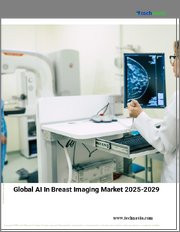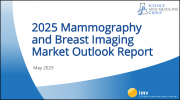
|
시장보고서
상품코드
1775447
세계의 유방 영상 진단 시장 : 예측(2025-2030년)Global Breast Imaging Market - Forecasts from 2025 to 2030 |
||||||
유방 영상 진단 시장은 2025년 50억 7,500만 달러에서 2030년에는 73억 9,400만 달러로 성장하며, CAGR은 7.82%로 예측됩니다.
유방암 발병률 및 인지도 증가
세계보건기구(WHO)가 지적한 바와 같이 유방암은 여전히 전 세계에서 여성이 가장 많이 걸리는 암 중 하나이며, 선진국과 개발도상국을 막론하고 큰 영향을 미치고 있습니다. 생존율이 낮은 주요 원인은 조기발견 프로그램이 미흡하고 정기검진에 대한 인식이 낮아 말기 진단으로 이어지는 경우가 많기 때문입니다. 유방암 발병률이 높아짐에 따라 조기 발견을 통해 위험을 크게 줄일 수 있는 적기 검진의 중요성에 대한 여성들의 인식이 높아지고 있습니다. 이러한 변화로 인해 첨단 유방 영상 진단 장비에 대한 수요가 증가하고 있으며, 의료 서비스 프로바이더가 진단 정확도와 환자 예후를 개선하는 기술을 우선시함에 따라 시장 확대에 박차를 가하고 있습니다.
첨단 영상 진단 기술 도입
시장은 진단 효율을 향상시키는 혁신적인 유방 영상 진단법의 채택으로 혜택을 누리고 있습니다. 분자 유방 영상법(MBI), 조영 유방촬영술(CEM), 양전자 방출 유방촬영술(PEM), 전기 임피던스 검사(EIT), 광학 영상 검사 등의 기술이 널리 보급되고 있습니다. 핵의학적인 접근법인 MBI는 화학적 추적자를 주입하고 전용 카메라를 사용하여 유방의 이상을 평가하는 것으로, 특히 유방밀도가 높은 여성이나 유방촬영술에 이상이 있는 여성에게 적합하며, CEM은 요오드 기반 조영제를 사용하여 비정상적인 유방조직을 강조하는 검사로, MRI에 비해 비용 대비 효과적이며 PET 검사와 유사한 PEM은 방사성 당을 사용하여 작은 암세포군을 검출하고, EIT는 암세포와 정상세포의 전기전도도 차이를 이용하며, 광 이미징은 빛의 투과율을 분석하여 암의 성장을 모니터링합니다. 이러한 방법들은 MBI와 PEM의 방사선 피폭 등의 문제점에도 불구하고 보다 정밀한 진단을 가능하게 함으로써 시장 발전에 기여하고 있습니다.
기술 발전
유방 영상 진단 기술의 끊임없는 혁신은 주요 촉진제입니다. 암세포의 확산을 감지하고 모니터링하는 기능이 향상된 첨단 시스템이 개발되어 진단의 정확성과 워크플로우의 효율성이 향상되고 있습니다. 각 제조업체들이 다양한 고성능 이미징 솔루션을 도입하고 있으므로 이러한 발전으로 인해 의료 현장에서의 채택이 증가할 것으로 예측됩니다. 보다 빠르고 정확한 결과를 제공하는 첨단 장비에 대한 관심은 유방암을 조기에 효과적으로 발견하려는 의료 서비스 프로바이더의 노력으로 인해 예측 기간 중 시장 성장을 가속할 것으로 예측됩니다.
시장이 해결해야 할 과제
기술의 발전에도 불구하고 MBI나 PEM과 같은 특정 영상 진단 기술은 방사선 노출로 인해 일상적인 검진에서 사용이 제한되어 있으며, EIT나 광학 영상 진단과 같은 새로운 방법은 추가적인 임상적 검증과 인프라 투자가 필요하여 보급에 걸림돌이 되고 있습니다. 이러한 문제들은 진단의 유효성과 환자의 안전성 및 접근성 사이의 균형을 맞추기 위한 지속적인 조사의 필요성을 강조하고 있습니다.
지역별 전망
북미는 높은 유방암 발병률과 사망률 증가로 인해 첨단 영상 진단 솔루션에 대한 투자와 인식 제고 캠페인이 활발히 진행되면서 예측 기간 중 압도적인 시장 점유율을 유지할 것으로 예측됩니다. 아시아태평양은 진단 시설 및 의료 인프라를 강화하기 위한 노력에 힘입어 시장 점유율을 확대할 것으로 예측됩니다. 이러한 지역적 동향은 헬스케어 우선순위와 투자의 차이를 반영하여 시장의 성장 궤도를 형성하고 있습니다.
결론
유방암 환자 증가, 조기 발견에 대한 인식 증가, 혁신적인 영상 기술에 힘입어 유방 영상 진단 시장은 강력한 성장세를 보이고 있습니다. 북미는 높은 질병 유병률과 투자 규모에서 선두를 달리고 있으며, 아시아태평양은 진단 인프라 개선을 통해 성장할 것으로 예측됩니다. 방사선 위험 및 도입 장벽과 같은 과제에도 불구하고 MBI, CEM, PEM, EIT, 광학 이미징 등의 발전으로 시장 기회가 확대되고 있습니다. 업계 전문가들은 시장의 미래를 형성하는 데 있으며, 기술 혁신과 지역 역학의 중요한 역할에 주목해야 합니다.
이 보고서의 주요 장점
- 인사이트 분석 : 고객 부문, 정부 정책 및 사회경제적 요인, 소비자 선호도, 산업별, 기타 하위 부문에 초점을 맞춘 주요 지역 및 신흥 지역을 포괄하는 상세한 시장 분석을 얻을 수 있습니다.
- 경쟁 구도: 세계 주요 기업이 채택하고 있는 전략적 전략을 이해하고, 적절한 전략을 통한 시장 침투 가능성을 파악할 수 있습니다.
- 시장 동향과 촉진요인 : 역동적인 요인과 매우 중요한 시장 동향, 그리고 이들이 향후 시장 발전을 어떻게 형성할 것인지에 대해 알아봅니다.
- 실행 가능한 제안: 인사이트를 전략적 의사결정에 활용하고, 역동적인 환경 속에서 새로운 비즈니스 스트림과 매출을 발굴합니다.
- 다양한 사용자에 대응: 스타트업, 연구기관, 컨설턴트, 중소기업, 대기업에 유익하고 비용 효율적입니다.
어떤 용도로 사용되는가?
산업 및 시장 인사이트, 사업 기회 평가, 제품 수요 예측, 시장 진출 전략, 지역적 확장, 설비 투자 결정, 규제 프레임워크 및 영향, 신제품 개발, 경쟁의 영향
조사 범위
- 2022-2024년의 과거 데이터 & 2025-2030년의 예측 데이터
- 성장 기회, 과제, 공급망 전망, 규제 프레임워크 및 동향 분석
- 경쟁사 포지셔닝, 전략 및 시장 점유율 분석
- 매출 성장 및 예측 국가를 포함한 부문 및 지역별 분석
- 기업 프로파일링(특히 재무 및 주요 개발)
목차
제1장 개요
제2장 시장 스냅숏
- 시장 개요
- 시장의 정의
- 조사 범위
- 시장 세분화
제3장 비즈니스 상황
- 시장 성장 촉진요인
- 시장 성장 억제요인
- 시장 기회
- Porter's Five Forces 분석
- 업계 밸류체인 분석
- 정책과 규제
- 전략적 제안
제4장 기술 전망
제5장 유방 영상 진단 시장 : 기술별
- 서론
- 맘모그래피
- 초음파
- 자기공명영상(MRI)
- 핵이미징
- 기타
제6장 유방 영상 진단 시장 : 시술별
- 서론
- 스크리닝 맘모그래피
- 진단용 맘모그래피
- 유방 토모신테시스
- 유방 초음파 검사
- 유방 MRI
- 기타
제7장 유방 영상 진단 시장 : 최종사용자별
- 서론
- 병원
- 진단 센터
- 조사실
제8장 유방 영상 진단 시장 : 지역별
- 서론
- 북미
- 미국
- 캐나다
- 멕시코
- 남미
- 브라질
- 아르헨티나
- 기타
- 유럽
- 독일
- 프랑스
- 영국
- 스페인
- 기타
- 중동 및 아프리카
- 사우디아라비아
- 아랍에미리트
- 이스라엘
- 기타
- 아시아태평양
- 중국
- 인도
- 일본
- 한국
- 호주
- 태국
- 기타
제9장 경쟁 환경과 분석
- 주요 기업과 전략 분석
- 시장 점유율 분석
- 합병, 인수, 합의 및 협업
- 경쟁 대시보드
제10장 기업 개요
- GE Healthcare
- Hologic, Inc.
- Siemens Healthineers AG
- Koninklijke Philips N.V.
- Fujifilm Holdings Corporation
- Canon Medical Systems Corporation
- Dilon Technologies, Inc.
제11장 부록
- 통화
- 전제조건
- 기준연도와 예측연도 타임라인
- 이해관계자에 대한 주요 이점
- 조사 방법
- 약어
The Global Breast Imaging Market is expected to grow from USD 5.075 billion in 2025 to USD 7.394 billion in 2030, at a CAGR of 7.82%.
Increasing Breast Cancer Incidence and Awareness
Breast cancer remains one of the most prevalent cancers affecting women globally, as noted by the World Health Organization, with significant impact in both developed and developing nations. Low survival rates are primarily due to inadequate early detection programs and limited awareness of routine screenings, leading to late-stage diagnoses. The growing incidence of breast cancer is driving heightened awareness among women about the importance of timely checkups, which significantly reduce risks through early detection. This shift is increasing demand for advanced breast imaging equipment, fueling market expansion as healthcare providers prioritize technologies that enhance diagnostic accuracy and patient outcomes.
Adoption of Advanced Imaging Techniques
The market is benefiting from the adoption of innovative breast imaging methods that improve diagnostic efficiency. Techniques such as molecular breast imaging (MBI), contrast-enhanced mammography (CEM), positron emission mammography (PEM), electrical impedance testing (EIT), and optical imaging tests are gaining traction. MBI, a nuclear medicine approach, involves injecting a chemical tracer and using a specialized camera to evaluate breast abnormalities, particularly for women with dense breasts or abnormal mammograms. CEM uses iodine-based contrast dye to highlight abnormal breast tissue, offering a cost-effective alternative to MRI. PEM, akin to PET scans, employs radioactive sugar to detect small cancer cell clusters. EIT leverages differences in electrical conductivity between cancerous and normal cells, while optical imaging analyzes light transmission to monitor cancer growth. These methods, despite challenges like radiation exposure in MBI and PEM, are driving the development of enhanced imaging equipment, contributing to market growth by enabling more precise diagnostics.
Technological Advancements
Continuous innovation in breast imaging technologies is a key growth driver. Advanced systems with improved capabilities for detecting and monitoring cancer cell spread are being developed, enhancing diagnostic precision and workflow efficiency. These advancements are expected to increase adoption across healthcare settings, as manufacturers introduce diverse, high-performance imaging solutions. The focus on sophisticated equipment that delivers faster, more accurate results is anticipated to propel market growth over the forecast period, as providers seek to meet rising demand for early and effective breast cancer detection.
Market Challenges
Despite technological progress, certain imaging techniques, such as MBI and PEM, involve radiation exposure, limiting their use in routine screening. Emerging methods like EIT and optical imaging require further clinical validation and infrastructure investment, posing barriers to widespread adoption. These challenges highlight the need for ongoing research to balance diagnostic efficacy with patient safety and accessibility.
Regional Outlook
North America is expected to maintain a dominant market share through the forecast period, driven by the high prevalence of breast cancer and increasing mortality rates, which are prompting greater investment in advanced imaging solutions and awareness campaigns. The Asia Pacific region is poised to expand its market share, supported by initiatives to enhance diagnostic facilities and healthcare infrastructure. These regional trends reflect varying healthcare priorities and investments, shaping the market's growth trajectory.
Conclusion
The breast imaging market is on a strong growth path, driven by rising breast cancer cases, growing awareness of early detection, and innovative imaging technologies. North America leads due to high disease prevalence and investment, while Asia Pacific is set to grow through improved diagnostic infrastructure. Despite challenges like radiation risks and adoption barriers, advancements in MBI, CEM, PEM, EIT, and optical imaging are expanding market opportunities. Industry experts should note the critical role of technological innovation and regional dynamics in shaping the market's future.
Key Benefits of this Report:
- Insightful Analysis: Gain detailed market insights covering major as well as emerging geographical regions, focusing on customer segments, government policies and socio-economic factors, consumer preferences, industry verticals, and other sub-segments.
- Competitive Landscape: Understand the strategic maneuvers employed by key players globally to understand possible market penetration with the correct strategy.
- Market Drivers & Future Trends: Explore the dynamic factors and pivotal market trends and how they will shape future market developments.
- Actionable Recommendations: Utilize the insights to exercise strategic decisions to uncover new business streams and revenues in a dynamic environment.
- Caters to a Wide Audience: Beneficial and cost-effective for startups, research institutions, consultants, SMEs, and large enterprises.
What do businesses use our reports for?
Industry and Market Insights, Opportunity Assessment, Product Demand Forecasting, Market Entry Strategy, Geographical Expansion, Capital Investment Decisions, Regulatory Framework & Implications, New Product Development, Competitive Intelligence
Report Coverage:
- Historical data from 2022 to 2024 & forecast data from 2025 to 2030
- Growth Opportunities, Challenges, Supply Chain Outlook, Regulatory Framework, and Trend Analysis
- Competitive Positioning, Strategies, and Market Share Analysis
- Revenue Growth and Forecast Assessment of segments and regions including countries
- Company Profiling (Strategies, Products, Financial Information, and Key Developments among others.
Segmentation:
By Technology
- Mammography
- Ultrasound
- Magnetic Resonance Imaging (MRI)
- Nuclear Imaging
- Others
By Procedure
- Screening Mammography
- Diagnostic Mammography
- Breast Tomosynthesis
- Breast Ultrasound
- Breast MRI
- Others
By End-User
- Hospitals
- Diagnostic Centers
- Research Laboratories
By Geography
- North America
- USA
- Canada
- Mexico
- South America
- Brazil
- Argentina
- Others
- Europe
- UK
- Germany
- France
- Spain
- Italy
- Others
- The Middle East and Africa
- Saudi Arabia
- UAE
- Israel
- Others
- Asia Pacific
- Japan
- China
- India
- Australia
- Indonesia
- Thailand
- Others
TABLE OF CONTENTS
1. EXECUTIVE SUMMARY
2. MARKET SNAPSHOT
- 2.1. Market Overview
- 2.2. Market Definition
- 2.3. Scope of the Study
- 2.4. Market Segmentation
3. BUSINESS LANDSCAPE
- 3.1. Market Drivers
- 3.2. Market Restraints
- 3.3. Market Opportunities
- 3.4. Porter's Five Forces Analysis
- 3.5. Industry Value Chain Analysis
- 3.6. Policies and Regulations
- 3.7. Strategic Recommendations
4. TECHNOLOGICAL OUTLOOK
5. BREAST IMAGING MARKET BY TECHNOLOGY
- 5.1. Introduction
- 5.2. Mammography
- 5.3. Ultrasound
- 5.4. Magnetic Resonance Imaging (MRI)
- 5.5. Nuclear Imaging
- 5.6. Others
6. BREAST IMAGING MARKET BY PROCEDURE
- 6.1. Introduction
- 6.2. Screening Mammography
- 6.3. Diagnostic Mammography
- 6.4. Breast Tomosynthesis
- 6.5. Breast Ultrasound
- 6.6. Breast MRI
- 6.7. Others
7. BREAST IMAGING MARKET BY END-USER
- 7.1. Introduction
- 7.2. Hospitals
- 7.3. Diagnostic Centers
- 7.4. Research Laboratories
8. BREAST IMAGING MARKET BY GEOGRAPHY
- 8.1. Introduction
- 8.2. North America
- 8.2.1. USA
- 8.2.2. Canada
- 8.2.3. Mexico
- 8.3. South America
- 8.3.1. Brazil
- 8.3.2. Argentina
- 8.3.3. Others
- 8.4. Europe
- 8.4.1. Germany
- 8.4.2. France
- 8.4.3. United Kingdom
- 8.4.4. Spain
- 8.4.5. Others
- 8.5. Middle East and Africa
- 8.5.1. Saudi Arabia
- 8.5.2. UAE
- 8.5.3. Israel
- 8.5.4. Others
- 8.6. Asia Pacific
- 8.6.1. China
- 8.6.2. India
- 8.6.3. Japan
- 8.6.4. South Korea
- 8.6.5. Australia
- 8.6.6. Thailand
- 8.6.7. Others
9. COMPETITIVE ENVIRONMENT AND ANALYSIS
- 9.1. Major Players and Strategy Analysis
- 9.2. Market Share Analysis
- 9.3. Mergers, Acquisitions, Agreements, and Collaborations
- 9.4. Competitive Dashboard
10. COMPANY PROFILES
- 10.1. GE Healthcare
- 10.2. Hologic, Inc.
- 10.3. Siemens Healthineers AG
- 10.4. Koninklijke Philips N.V.
- 10.5. Fujifilm Holdings Corporation
- 10.6. Canon Medical Systems Corporation
- 10.7. Dilon Technologies, Inc.
11. APPENDIX
- 11.1. Currency
- 11.2. Assumptions
- 11.3. Base and Forecast Years Timeline
- 11.4. Key benefits for the stakeholders
- 11.5. Research Methodology
- 11.6. Abbreviations



















